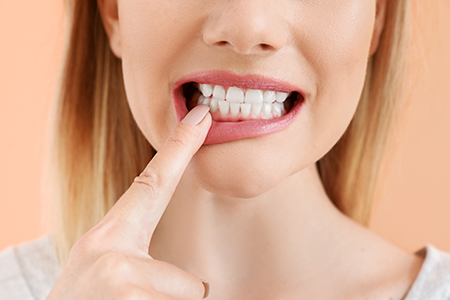General & Cosmetic Dentistry
The office of Keith A. Kye, DDS, FAGD serves the neighborhoods of Huntersville, Lake Norman, Davidson and Cornelius.


Nearly half of adults over the age of 30 show signs of periodontal (gum) disease — a leading cause of tooth loss and a condition that quietly affects overall health. With attentive care and timely treatment, most cases can be controlled or reversed before they cause lasting damage. At the office of Keith A. Kye, DDS, FAGD, we take a preventive, personalized approach to periodontal care so patients can keep healthy gums and comfortable, reliable smiles.
Periodontal disease is the name given to inflammatory conditions that harm the tissues that surround and support teeth. These tissues — the gums, ligaments, and the underlying bone — can be slowly damaged when bacteria from plaque and tartar persist along the gumline. Instead of an isolated tooth problem, periodontal disease affects the foundation that keeps the whole smile stable.
The early stages of the disease often produce mild or no pain, which is why many people do not recognize it right away. Signs can be subtle: gums that bleed a little when you brush, a slight change in breath, or minor sensitivity. Because the progression can be gradual, regular dental examinations are crucial for detection and intervention before more tissue is lost.
When allowed to advance, the infection can create pockets between teeth and gums, lead to gum recession, and eventually erode the bone that anchors teeth. The goal of periodontal care is not only to address symptoms, but to remove the cause — bacterial buildup — and to restore an environment where healthy tissue can be maintained long term.
Patients who know what to watch for are far more likely to get help early. In addition to bleeding and redness, other indicators can include persistent bad breath, gums that pull away from the teeth, swollen or tender areas, and teeth that feel loose or appear to shift. Any change in how your bite feels or how your partial denture fits can also be connected to gum problems.
Because these signs can overlap with other oral issues, a professional exam is the only way to confirm periodontal disease and to measure its extent. Dentists assess pocket depths, evaluate gum contour and bone support, and use imaging when needed to build a clear picture of periodontal health before recommending treatment.
Pay attention to risk factors that increase susceptibility: smoking, uncontrolled diabetes, certain medications, and inconsistent oral hygiene all raise the likelihood of disease. Identifying and managing these contributors is an important part of any effective periodontal plan.

Gingivitis is the earliest stage of gum disease and is often entirely manageable when treated promptly. It is characterized by inflammation of the gum tissues without loss of the bone that supports teeth. At this point, professional care combined with a better home routine will usually return the gums to health.
Treatment for gingivitis commonly involves a thorough professional cleaning to remove plaque and tartar from above and below the gumline, followed by instruction on more effective brushing and flossing techniques. For many patients, addressing lifestyle factors and committing to regular maintenance visits is all that’s required to prevent recurrence.
Because gingivitis is both common and reversible, it represents an opportunity: intervene now, and you can avoid the more complex procedures needed for advanced disease. Our team focuses on clear guidance, hands-on education, and follow-up care so patients leave equipped to protect their gum health.

Once gingivitis progresses into periodontitis, the infection reaches deeper structures and begins to destroy the connective tissues and bone surrounding teeth. At this stage, pockets deepen and are harder to clean with routine brushing alone. Without treatment the structural support can be compromised, and tooth loss becomes a greater risk.
Periodontitis is typically staged by severity and by how quickly it is progressing. Early, localized bone loss differs from widespread, rapidly advancing disease and requires different clinical decisions. A thorough assessment — including clinical measurements and radiographs — helps determine the most appropriate course of action for each patient.
Although damage to bone and attachment tissues can be permanent, modern periodontal therapy aims to stop the destructive process and, where possible, restore lost support. That may include mechanical removal of bacterial deposits, medications to reduce infection, and surgical techniques designed to regenerate tissue when indicated.

Periodontal therapy begins with the least invasive yet effective measures and progresses to surgical options only when necessary. For many patients, a thoughtful combination of professional deep cleanings, improved home care, and targeted antimicrobial strategies can control disease and bring gums back to a healthy condition. Treatment plans are individualized to reflect the severity of disease, medical history, and patient goals.
In cases where pockets are too deep or when bone loss is significant, surgical intervention may be required. Surgical techniques are designed to access and thoroughly clean root surfaces, reduce pocket depth, and reposition or reconstruct soft tissue. Advances in dental technology — including lasers and improved materials for grafting — have expanded the options for restoring periodontal health.
Medications are sometimes used as adjuncts to mechanical therapy. Topical antimicrobials placed under the gumline, short courses of systemic antibiotics when appropriate, and agents that support tissue regeneration can all be part of a comprehensive approach. The objective is always to reduce the bacterial load, modulate inflammation, and create conditions favorable to healing.
Follow-up care is essential. After active treatment, patients typically enter a maintenance schedule tailored to their needs — often more frequent cleanings and monitoring than routine dental recalls — to preserve results and detect any signs of recurrence early.
When disease is detected early, conservative measures are the first line of defense. Scaling and root planing — targeted, deeper cleanings below the gumline — remove plaque and hardened deposits from root surfaces and smooth those roots so tissues can reattach more easily. These procedures are effective for arresting progression in many cases.
Adjunctive therapies such as localized antimicrobial treatment or prescription rinses can enhance the results of mechanical cleaning. The overall goal is to restore an environment where daily oral hygiene and routine maintenance can keep the disease from returning.
Patients who respond well to non-surgical care usually move into a personalized maintenance program with periodic reassessment to ensure stability over time.
For advanced disease or areas that don’t respond to conservative therapy, surgical procedures can access deep pockets, reshape diseased tissue, and place grafts when necessary to regenerate lost bone and attachment. Flap procedures allow clinicians to thoroughly clean root surfaces and, when appropriate, perform regenerative work to restore support.
Contemporary periodontal surgery may include the use of bone grafts, guided tissue regeneration membranes, soft tissue grafting for recession coverage, and implant-related interventions when supporting structures need rebuilding. These techniques aim to reestablish function and improve long-term prognosis.
Minimally invasive tools, including certain laser applications, can sometimes be used to complement traditional surgery and reduce healing time. Each case is evaluated carefully to select the safest and most effective modality.
Successful periodontal care does not end when active treatment is complete. Long-term stability depends on a partnership between patient and clinician: consistent, effective home care, management of risk factors, and a maintenance schedule based on individual needs. Patients who commit to this partnership dramatically reduce the chance of relapse.
Behavioral factors such as smoking cessation, controlling systemic conditions like diabetes, and improving daily oral hygiene make a measurable difference. Our clinical team works with patients to create realistic, achievable routines and to provide the tools and instruction needed for lasting results.
Regular periodontal monitoring allows us to intercept any changes early. When small problems are found quickly, simple interventions often prevent the need for more extensive procedures later on. That proactive approach protects both oral health and the investment of time put into treatment.
To learn more about how we evaluate and treat gum disease, and to discuss an individualized plan for your needs, please contact our office for more information. Our team is available to answer questions and to guide you toward a healthier, more resilient smile.
Most people don’t realize that periodontal disease is the leading cause of tooth loss among adults. According to statistics from the Centers for Disease Control and Prevention, one out of every two adults over the age of 30 in the United States has periodontal disease.
You may be surprised to learn that the human mouth is home to a wide variety of microbes. The fact is that over 700 different strains of bacteria have been detected in the oral cavity. Although some of these bacteria are beneficial, others are harmful to oral health. Without proper oral hygiene and routine dental care, these harmful bacteria can cause tooth decay and gum disease, compromising both your oral health and overall wellbeing.
In addition to inadequate oral hygiene and infrequent professional care, other factors, including smoking, genetic tendencies, and unchecked diabetes, can contribute to the escalation of periodontal disease.
Your gums and teeth have an interdependent relationship, which means healthy teeth depend on the support of healthy gums. Also, taking care of your smile does more than keep your teeth and gums in optimal condition; good oral health also supports systemic health. In addition to being the leading cause of tooth loss in adults, researchers are finding more and more links between periodontal disease and a number of medical problems, including heart disease, stroke, diabetes, respiratory problems, and adverse pregnancy outcomes such as pre-term and low birth-weight babies.
If you notice that your gums are bleeding with the slightest pressure while brushing or flossing, it’s a sign of gingivitis. Although gingivitis is the earliest stage of gum disease, it can easily be reversed with deeper cleanings as well as an improved regimen of oral hygiene at home.
In the absence of professional treatment and better home care, gingivitis progresses to the next stage, which is known as periodontitis. In this stage, the connective tissue and bone that hold the teeth in place begin to break down with an increase in pocketing between the teeth and bone, gum recession, and bone loss. Without proper treatment by your dentist, periodontitis will progress from a mild to moderate loss of supporting tissue to the destruction of the bone around the teeth.
Although gingivitis can often be reversed with improved oral hygiene and professional cleanings, as periodontal disease advances, more extensive procedures are required to halt its progression. Based on a complete assessment of your periodontal health and a review of possible contributing factors, our office will recommend the best options in care. Treatment for periodontitis may include a series of deeper cleanings known as root planing and scaling, surgical procedures to reduce pocket depth, bone or tissue grafts, laser procedures, or antimicrobial medications.
The cost of care depends on the type of procedures required to restore your periodontal health. If you have dental insurance, plans often cover treatment to prevent gum disease as well as many procedures to treat the various stages of gum disease. Our goal is to help patients restore and maintain good oral health. We do all we can to help you begin care without additional stress or delay. Our business office works with you to maximize your benefits and provide easier, more convenient payment options.
By seeing our office regularly for care and doing your best to eat a healthy diet and practice good oral hygiene, you can keep your smile in tip-top shape as well as protect your overall wellbeing.
At the office of Keith A. Kye, DDS, FAGD, we provide a comprehensive range of services to address all your oral healthcare needs. You can rest assured that your smile is in the best of hands at our office. Our skilled and experienced team maintains a position at the forefront of advances in care and remains dedicated to providing the highest quality of skilled and compassionate treatment.
Periodontal disease describes inflammatory conditions that affect the tissues surrounding and supporting the teeth, including gums, periodontal ligaments and underlying bone. The condition begins when bacterial plaque and hardened tartar accumulate along the gumline and provoke an immune response. Over time this inflammation can damage attachment fibers and the jawbone that anchors teeth, threatening long-term stability.
Early stages are often reversible with professional care and improved home hygiene, while advanced disease requires more intensive therapy. The main goal of periodontal treatment is to remove the bacterial cause, control inflammation and preserve as much natural tissue as possible. Regular monitoring and maintenance help prevent recurrence and protect overall oral health.
Gum disease is driven primarily by bacterial biofilms that form on teeth and along the gumline, but several factors raise a person's susceptibility. Smoking, uncontrolled diabetes, certain medications that reduce saliva, genetic predisposition and inconsistent oral hygiene are common contributors. When these risks combine they make it harder for the body and for professional treatments to control infection.
Age and hormonal changes, including pregnancy or menopause, can also influence gum health, as can stress and conditions that suppress immune response. Orthodontic appliances or poorly fitting restorations may create areas where plaque accumulates. Identifying and managing these risk factors is an important part of successful periodontal care.
Common signs that should prompt a periodontal evaluation include gums that bleed during brushing or flossing, persistent bad breath, and gums that appear red, swollen or tender. Receding gums, visible pockets or changes in the way teeth fit together when you bite are also important warning signals. Because early stages often cause little pain, routine dental assessments are essential for detection.
If you notice loose teeth, sensitivity near the gumline, or a partial denture that no longer fits correctly, arrange for a professional exam. A thorough evaluation can distinguish periodontal disease from other conditions and measure its severity. Prompt diagnosis increases the chances that conservative therapy will be effective.
Diagnosis begins with a clinical examination that includes measuring pocket depths around each tooth, checking for bleeding on probing and assessing tooth mobility. Dental radiographs are used when needed to evaluate bone levels and detect areas of hidden bone loss. A complete medical and dental history helps identify systemic or lifestyle factors that affect treatment choices.
Periodontal charting and staging classify how advanced the disease is and whether it is progressing rapidly or slowly. This information guides individualized treatment planning and helps set realistic expectations for outcomes. Periodic reassessment during and after treatment ensures the plan remains appropriate.
Initial non-surgical therapy typically centers on scaling and root planing, a careful deep cleaning that removes plaque and calculus from beneath the gumline and smooths root surfaces to encourage reattachment. Adjuncts such as localized antimicrobial agents placed into periodontal pockets or prescription rinses may enhance results for targeted areas. These measures aim to lower bacterial levels and reduce inflammation without surgical intervention.
Equally important is improving daily home care, including effective brushing, interdental cleaning and possibly the use of specialized aids to reach difficult areas. Many patients respond well to non-surgical care and then transition into a tailored maintenance schedule. Ongoing professional monitoring determines whether further treatment is needed.
Surgical or regenerative procedures are considered when deep pockets persist, bone loss is significant, or areas fail to respond to non-surgical therapy. Common approaches include flap surgery to access and thoroughly clean root surfaces, soft tissue grafting to address recession, and bone grafts or membranes to support regeneration of lost structures. These techniques seek to reestablish a healthier architecture that is easier to maintain with daily care.
Treatment selection depends on the extent and location of disease, overall health and patient goals, with an emphasis on minimally invasive options when appropriate. Contemporary tools such as certain laser applications can complement traditional surgery and may reduce postoperative discomfort and healing time. A careful discussion of risks, benefits and expected outcomes guides the decision-making process.
Antibiotics and topical antimicrobials are useful adjuncts to mechanical cleaning but are not a replacement for thorough removal of bacterial deposits. Topical agents delivered directly into pockets can provide high local concentrations with limited systemic exposure, while short courses of systemic antibiotics may be prescribed in specific situations. Host-modulating therapies that influence the body's inflammatory response are also an evolving part of periodontal care for selected patients.
Clinicians weigh the potential benefits against risks such as antibiotic resistance and side effects, and they tailor medication use to the individual case. Accurate diagnosis, proper delivery and follow-up are essential to maximize benefit and limit unnecessary use. Clear communication about how medications fit into the overall treatment plan improves adherence and outcomes.
After periodontal treatment, meticulous home care is critical to long-term success and often includes twice-daily brushing with a soft or electric toothbrush and daily interdental cleaning with floss or interdental brushes. Some patients benefit from adjunctive tools such as antimicrobial rinses, interdental picks or water flossers to control plaque in hard-to-reach areas. Smoking cessation, good nutrition and control of systemic conditions like diabetes support healing and reduce the risk of recurrence.
Following the active phase of therapy most patients enter a maintenance program with more frequent professional cleanings and monitoring than routine dental recalls. These visits allow early detection of changes and timely intervention before disease progresses. Patients who adhere to both home and professional care dramatically improve their long-term prognosis.
Research shows links between periodontal inflammation and systemic health, with studies associating gum disease with conditions such as diabetes and cardiovascular disease, though these relationships are complex and not strictly causal. Chronic oral inflammation can contribute to the body's overall inflammatory burden, making it important to manage periodontal disease as part of comprehensive health care. Controlling gum infection may improve quality of life and help stabilize related medical conditions when coordinated with a physician.
If you have a chronic condition such as diabetes, heart disease or a compromised immune system, inform your dental team so treatment can be coordinated appropriately. The office of Keith A. Kye, DDS, FAGD works with patients and their medical providers when necessary to ensure safe, effective care. Close communication and regular periodontal assessments help reduce risks and support overall well-being.
Frequency of periodontal maintenance visits is individualized based on disease severity, response to treatment and risk factors, and many patients begin with three-month intervals during the first year after therapy. Some individuals may require more or less frequent recalls depending on how stable their condition is and on lifestyle or medical factors. Regular maintenance is the best strategy to detect new inflammation early and to protect treatment outcomes over time.
Maintenance visits typically include careful evaluation of pocket depths, targeted removal of subgingival deposits and reinforcement of home care techniques. Patients should report any new symptoms such as bleeding, swelling or changes in tooth position between appointments. To establish a personalized schedule and ongoing plan, contact our office and speak with a member of the clinical team at Keith A. Kye, DDS, FAGD.

The office of Keith A. Kye, DDS, FAGD serves the neighborhoods of Huntersville, Lake Norman, Davidson and Cornelius.